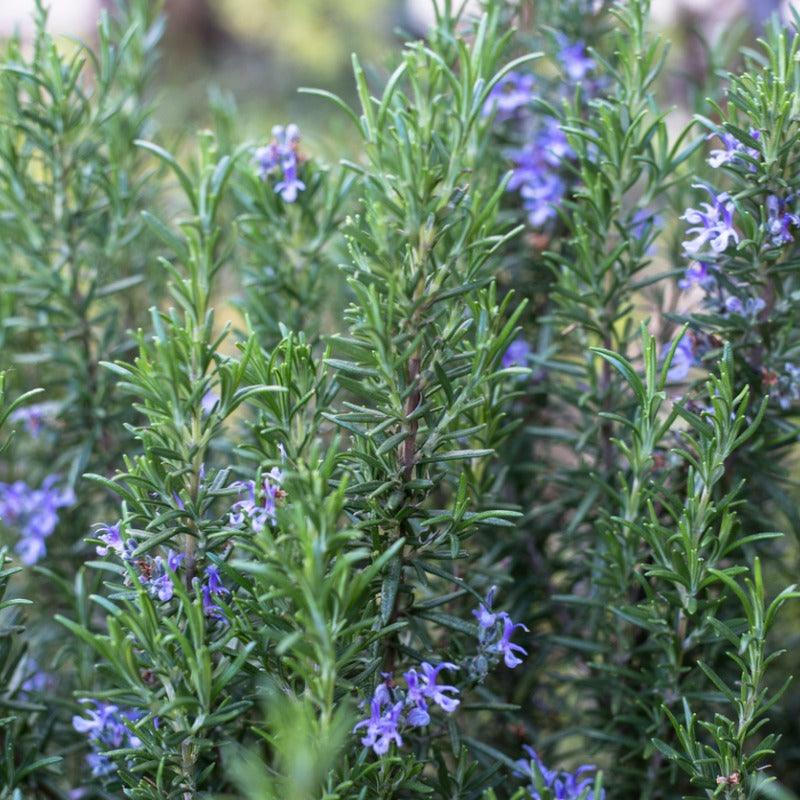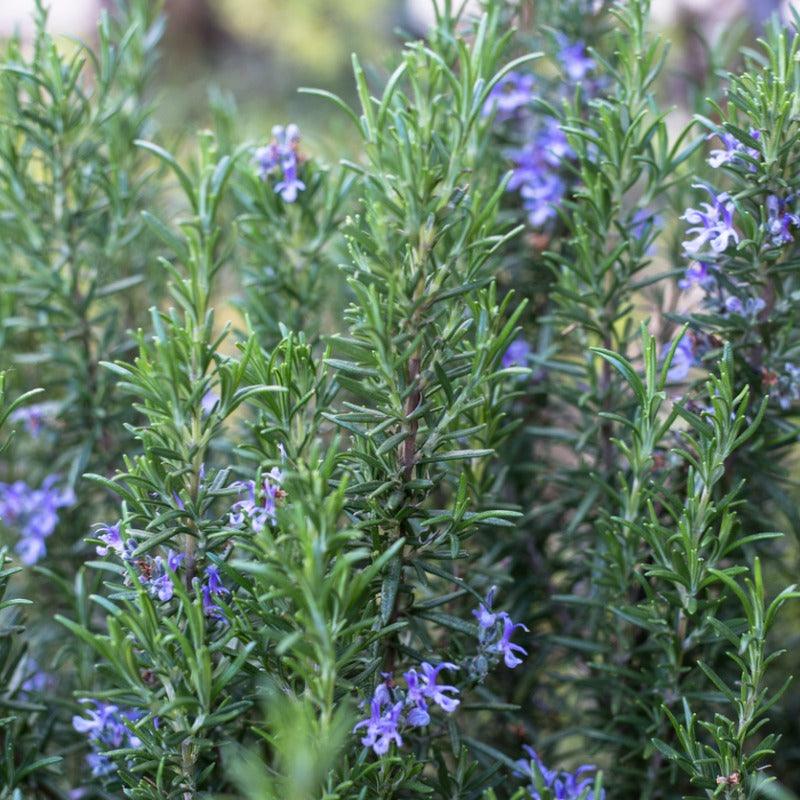Item Number: PV213
Organic Tuscan Blue Rosemary (1 Gallon)
Deep purple-blue flowers with exquisite scent
Tuscan Blue Rosemary, scientifically known as Rosmarinus officinalis ‘Tuscan Blue,’ is a remarkable variety of rosemary that stands out for its attractive, upright growth and aromatic qualities. This evergreen shrub boasts strongly aromatic, olive green, needle-like leaves and clusters of deep blue, tubular flowers from winter through spring. Known for its ease of maintenance and undemanding nature, Tuscan Blue Rosemary is a favored choice for hedges, privacy screens, and waterwise gardens. The leaves, rich in essential oils, are highly valued for culinary uses and can be used fresh or dried to flavor a variety of dishes.
Growing Tuscan Blue Rosemary
Growing Tuscan Blue Rosemary is relatively straightforward, making it an excellent choice for both novice and experienced gardeners. Here are some key aspects to consider:
Light Requirements: Tuscan Blue Rosemary thrives in full sun, needing at least six to eight hours of direct sunlight each day to develop its full flavor and aromatic qualities. In regions with hot summers, some afternoon shade can be beneficial.
Soil Preferences: This rosemary variety prefers poor to moderately fertile, well-drained soils. It can thrive in sandy or gravelly soils, making it a suitable choice for rock gardens and Mediterranean-style landscapes. Good drainage is crucial to prevent root rot, a common issue in waterlogged soils.
Watering Needs: Once established, Tuscan Blue Rosemary is drought tolerant, requiring minimal watering. In the initial stages after planting, ensure the soil remains consistently moist but not waterlogged to help the roots establish. After the first growing season, reduce watering frequency, especially in areas with regular rainfall.
Maintenance: Tuscan Blue Rosemary requires minimal maintenance. Regularly remove unsightly or dead shoots to maintain a tidy appearance. Since rosemary blooms in summer and late fall on the previous or current year’s growth, prune plants lightly in mid to late spring to encourage healthy growth and flowering.
Pest and Disease Management: Tuscan Blue Rosemary is virtually disease-free. However, gardeners should watch for thrips and rosemary beetles, which can occasionally infest the plants. Regular inspection and prompt action at the first sign of trouble can help keep these pests in check.
Uses of Tuscan Blue Rosemary
Tuscan Blue Rosemary is a versatile herb with numerous uses, both culinary and ornamental:
Culinary Uses: The aromatic leaves of Tuscan Blue Rosemary are highly valued in the kitchen. They can be used fresh or dried to flavor a variety of dishes, including roasted meats, vegetables, stews, and breads. The intense flavor of the leaves makes them a perfect addition to marinades and rubs.
Ornamental Uses: With its upright growth habit and attractive foliage, Tuscan Blue Rosemary is an excellent choice for hedges, privacy screens, and borders. It adds a touch of Mediterranean charm to gardens and landscapes. The deep blue flowers are also attractive to bees, butterflies, and hummingbirds, making it a great plant for pollinator gardens.
Waterwise Gardens: Due to its drought tolerance, Tuscan Blue Rosemary is ideal for xeriscaping and waterwise gardens. It can thrive with minimal water once established, making it an environmentally friendly choice for dry climates.
Popular Tuscan Blue Rosemary Recipes
Tuscan Blue Rosemary’s culinary potential is vast, and it can be used in a variety of recipes to enhance flavor:
- Rosemary Roasted Potatoes: Toss quartered potatoes with olive oil, minced garlic, and chopped Tuscan Blue Rosemary leaves. Roast in the oven until golden brown and crispy.
- Rosemary Lemon Chicken: Marinate chicken breasts in a mixture of lemon juice, olive oil, chopped rosemary, garlic, salt, and pepper. Grill or bake until cooked through for a flavorful, aromatic dish.
- Rosemary Infused Olive Oil: Combine olive oil with a few sprigs of fresh Tuscan Blue Rosemary in a bottle. Let it sit for a few days to infuse the oil with rosemary’s aromatic flavor. Use the infused oil for cooking or as a finishing oil for salads and breads.
- Rosemary Bread: Add chopped rosemary leaves to your favorite bread dough recipe for a fragrant, herb-infused loaf.
- Rosemary Simple Syrup: Combine sugar, water, and fresh rosemary sprigs in a saucepan. Simmer until the sugar is dissolved and the syrup is infused with rosemary flavor. Use this syrup to sweeten and flavor cocktails, lemonades, or iced teas.
Growing Tuscan Blue Rosemary Indoors
For those without garden space, growing Tuscan Blue Rosemary indoors is a viable option:
Container Selection: Choose a pot with adequate drainage holes to prevent waterlogging. A terra cotta pot is a good choice as it allows for better air circulation around the roots.
Indoor Light Requirements: Place the pot in a location where it will receive plenty of sunlight. A south-facing window is ideal. If natural light is insufficient, consider using grow lights to supplement.
Watering Indoors: Indoor rosemary plants need regular watering to keep the soil moist but not soggy. Be careful not to overwater, as this can lead to root rot.
Pruning and Maintenance: Indoor Tuscan Blue Rosemary requires regular pruning to maintain a healthy, bushy appearance. Pinch back new growth to encourage a fuller plant and remove any yellow or dead leaves promptly.
Conclusion
Growing Tuscan Blue Rosemary offers a range of benefits, from enhancing your culinary creations to providing a fresh, aromatic element to your garden or home. Whether you choose to grow it outdoors or indoors, this versatile herb is relatively easy to cultivate and maintain. Its historical significance and cultural importance, particularly in Mediterranean cuisine, add to its charm. For those interested in starting their own rosemary patch. By following the guidelines outlined above, you can enjoy a thriving rosemary plant and the delightful flavors it brings to your kitchen. Whether you’re seasoning a roast, flavoring a bread, or simply enjoying the fragrant foliage, Tuscan Blue Rosemary is a valuable addition to any garden or culinary repertoire.

Check Your Zone Compatibility:
Compatible with your zone.
Growing Zone for

Our Guarantee To You
Since 1976, we've served our customers at every stage of growing. Please contact us at any time. We are happy to support and assist you.
Shipping Information
Shipping Information
Shipping Weight: 5.0 lb
Features
Features
- Attracts Bees/Butterflies
- Container Compatible
- Does Not Require Support
- Drought Tolerant
- Edible Flower
- Fragrant
- Good for Drying
- Heat Tolerant
- Open-Pollinated
- Useful for Ornamental
Characteristics
Characteristics
Planting & Care
Planting & Care
Soil and Water: Very drought tolerant once established, water regularly the first year then be careful not to over water. Rosemary thrives in various soil types.
Planting and Growing: Plants thrive in hot dry conditions and prefer well drained soil. Rosemary is slow growing the first year.
Harvesting and Storage: Harvest whole stems to flavor meats and soups or crush leaves with root vegetables, breads and many other culinary uses.
Useful Information
Useful Information
Guarantee
Guarantee
We guarantee the perishable items we sell to be in good, viable condition when we sell them. Perishable items include, but are not limited to, garlic bulbs, flower bulbs, seed potatoes, onion sets & transplants, potted or bare root trees, vegetable crowns, etc. If your perishable item arrives in substandard condition, take photographs and please contact us within 3 days of the purchase date (or delivery date) and we will provide you with a refund of the purchase price (excluding shipping costs), or a replacement. Accordingly, we urge you to open any boxes marked as ""Perishable"" immediately upon receiving them and inspect the shipment thoroughly (do not crack open heads of garlic, we do not accept claims on cracked garlic). Because some perishable items can deteriorate very quickly, we cannot accept any claims beyond the 3-day time frame as it becomes too difficult to determine if these items were delivered in substandard condition, or if they turned into such substandard condition because of having been improperly cared for or stored once delivered.
Share




